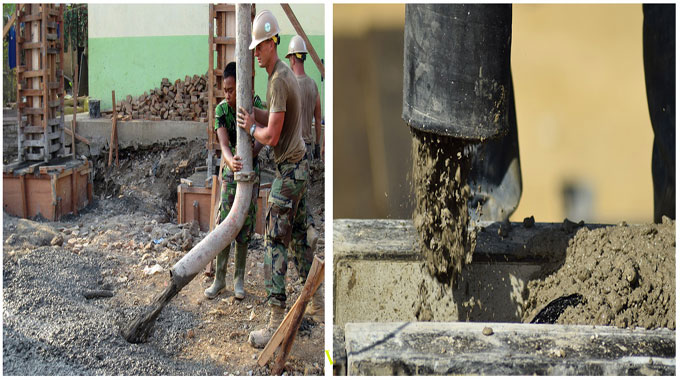
Steps included in concrete manufacturing

The concrete quality depends on the manufacturing process of concrete. The manufacturing process involves the following steps :- Batching or measurement of materials, Mixing, Transportation, Placing, Compacting, Curing.
Batching of Material: To maintain the standard of concrete, the quantities of the materials should be perfect. The cement, aggregates and water should have utilized along with 3 percent of batching quantity and the admixture along with the 5 percent of batching quantity. Generally, two types of batching like the volume batch and the weight batch are utilized. The selection of batching method is influenced by the size of job, necessary production rate, and required standards of batching performance.
Volume Batching: Volume batch is suitable for the small works only. The amount of concrete materials is calculated with loose volume by means of standard box alias volume gauge box made of wood or metal. The amount of solid granular material in a cubic meter will be considered as an indefinite quantity. As for instance, the volume of moist sand in a loose condition weights much less as compared to the identical volume of dry compacted sand. Cement is calculated with weight in spite of the methods of batching. The cement is always calculated in terms of weight. The volume of one bag cement (50 kg) is 0.035 m.
Weight Batching: For all types of larger works, weight batching is recommended. There are several types of weight batches.
For small works, manually weight batch is ideal. All the materials are calculated manually by weight. The weight is taken in ordinary weight platform machine. The buckets are applied for large works. The bucket releases the materials directly into the mixture machine. For small to large works, manually or electrically operated automatic batching plants are used.
Mixing: The strength of the concrete relies on the mixing of materials. Standardized mixing process allows to mix the cement to aggregates in a proper way. There should be a coating of cement past on all the aggregate particles and all the materials of the concrete should be mixed into a homogeneous mass when the mixing is performed either by hand or machine.
Transportation of concrete: The concrete can be transported either by normally of mechanically. The concrete is transported manually through pans, wheel carts for small works whereas for large and enormous works, the concrete is transported through buckets or by pumps controlled mechanically.
Placing of concrete: Placing of concrete means arranging the concrete in its desired position. Concrete should be set in position in a perfect way as rapidly as possible within the initial setting time of the cement. Occasionally, admixture is utilized to raise the initial setting time.
Compaction of concrete: Compaction stands for the method for elimination of air voids from the concrete since air voids in concrete creates the vacuum and it reduces the concrete strength significantly. Compaction is performed manually or mechanically. The damping rods are employed in manual system. In mechanical process, vibrators are utilized. The manual compaction system is effective for small size of works. The vibrators are recommended for large size works. Vibrators are categorized into three types, internal vibrators, external vibrators and table vibrators.
Curing of concrete: Curing is vital for strength development and stability of concrete. Curing is started right away after placing and finishing of concrete, and entails maintenance of desired moisture and temperature conditions, both at depth and adjacent to the surface, for elongated periods of time. Properly cured concrete contains a sufficient amount of moisture for continued hydration and formation of strength, volume stability, endurance to freezing and thawing, and abrasion and scaling resistance.
For ordinary Portland cement, the period of curing time is from 7 days to 14 days. In case of rapid cement, the curing time is decreased.


